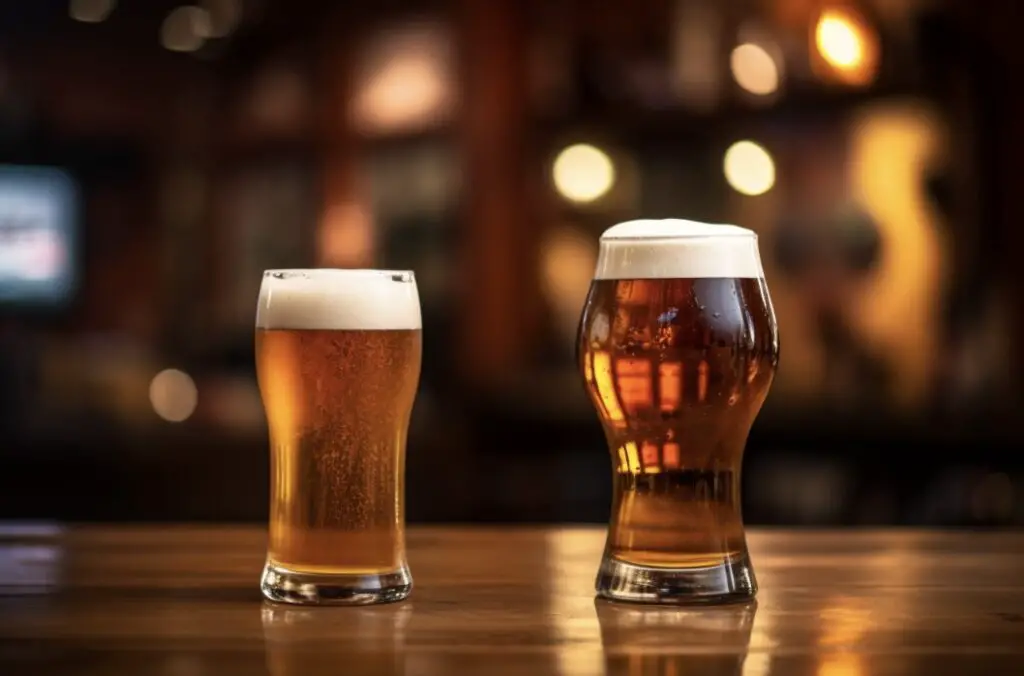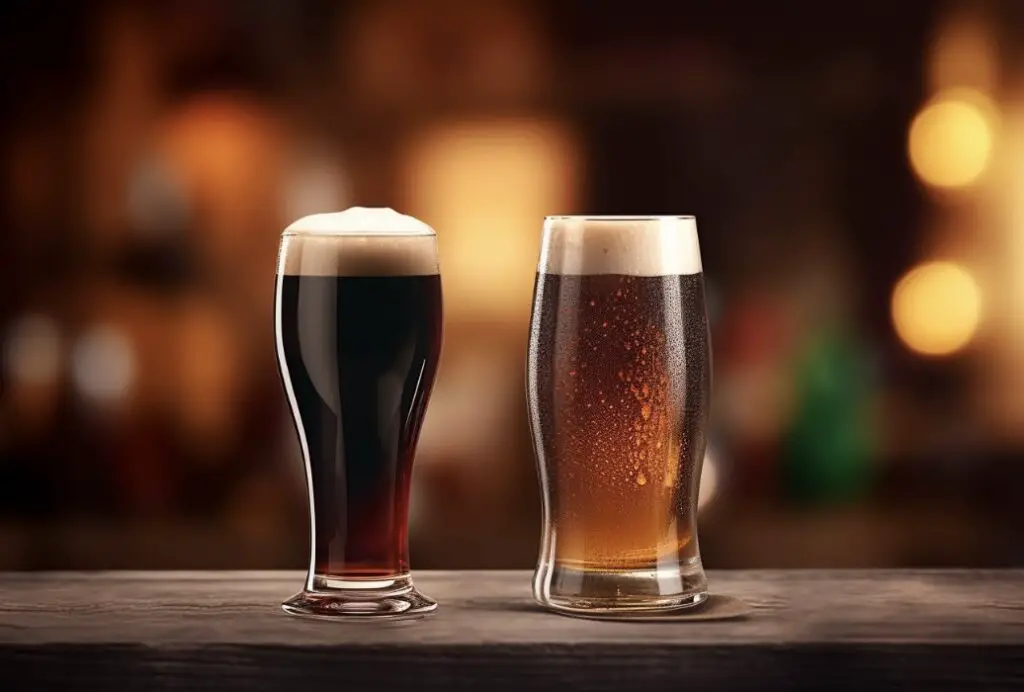Ah, the age-old question: is a stout a lager or an ale?
As an expert brewer and beer enthusiast, I’ve been asked this question countless times, and I’ve tasted my fair share of these delightful brews too.
The answer is that a stout is an ale – and I will get more into detail below!
In this blog post, I’ll delve into the details of what sets a stout apart from a lager, my personal experiences with tasting these beers, and the brewing process of each. So, grab a cold one and let’s get into it!
What Makes an Ale an Ale?
Before we dive into the world of stouts, it’s essential to understand the defining characteristics of an ale. Ales are a type of beer brewed with top-fermenting yeast (Saccharomyces cerevisiae) at warmer temperatures, usually between 60-75°F (15-24°C).
This yeast produces a more complex flavor profile due to the production of esters and phenols, which contribute fruity and spicy notes. Ales are typically full-bodied, robust, and aromatic.
The Difference Between a Lager and an Ale
Now that we know the basics of an ale, let’s look at the defining characteristics of a lager.

Lagers and ales are two broad categories of beer, and they differ in several key aspects, including fermentation process, yeast type, flavor profile, and serving temperatures. Here are the main differences between lagers and ales:
- Fermentation process: Lagers are fermented at cooler temperatures, typically between 45°F (7°C) and 55°F (13°C), using bottom-fermenting yeast. Ales, on the other hand, are fermented at warmer temperatures, usually between 60°F (15°C) and 75°F (24°C), using top-fermenting yeast.
- Yeast type: Lagers are brewed with bottom-fermenting yeast strains, known as Saccharomyces pastorianus. These yeast strains tend to settle at the bottom of the fermentation vessel and work more slowly. Ales, on the contrary, are brewed with top-fermenting yeast strains, known as Saccharomyces cerevisiae. Top-fermenting yeasts ferment at higher temperatures and rise to the top of the fermentation vessel.
- Fermentation time: Lagers require a longer fermentation and maturation time compared to ales. Lagers are often aged for several weeks to several months at near-freezing temperatures, a process called lagering, which contributes to their clean and crisp character. Ales, on the other hand, have a shorter fermentation period and are typically ready to drink sooner.
- Flavor profile: Lagers tend to have a clean, crisp, and smooth flavor profile. They often exhibit subtle maltiness, mild hop bitterness, and a light to medium body. Ales can have a wide range of flavors, ranging from fruity and estery to malty and hoppy. Ales generally offer a broader spectrum of flavors and can be more complex.
- Carbonation: Lagers are typically highly carbonated with a moderate to high level of carbonation. This higher carbonation level contributes to their refreshing quality. Ales, while still carbonated, generally have a lower level of carbonation compared to lagers.
- Serving temperature: Lagers are best served at colder temperatures, typically between 38°F (3°C) and 45°F (7°C). The colder serving temperature helps to accentuate their crispness and refreshment. Ales are typically served at slightly warmer temperatures, usually between 45°F (7°C) and 55°F (13°C), which allows their flavors to be more pronounced.
- Styles: Each category encompasses a wide range of beer styles. Some popular lager styles include Pilsner, Munich Helles, Vienna Lager, and Bock. Common ale styles include Pale Ale, India Pale Ale (IPA), Stout, Porter, Belgian Ale, and Wheat Beer.
It’s worth noting that while these differences generally hold true, there can be some overlap and variations within each category as craft brewers continue to innovate and experiment with different brewing techniques and ingredients.
The Stout: A Dark and Rich Ale
A stout is a dark, rich ale characterized by its roasted malt flavors, which can range from coffee to chocolate, and even burnt toast. Stouts are typically brewed with a higher proportion of roasted barley, which gives them their distinct color and taste. Let’s take a closer look at the brewing process and some of the factors that make stouts stand out from other ales.
The Brewing Process: Stout vs. Lager
The brewing process for a stout, being an ale, is similar to that of other ales. The warm fermentation process using top-fermenting yeast allows for the development of rich, complex flavors. The addition of roasted barley or malt imparts the characteristic roasted flavors and dark color. On the other hand, lagers undergo a cold fermentation process with bottom-fermenting yeast, resulting in a smoother, cleaner taste.
My Personal Stout Tasting Experiences
As a brewer and beer enthusiast, I’ve had the pleasure of tasting a wide variety of stouts. One of my favorites is the classic Guinness, an Irish dry stout. When pouring a Guinness, the first thing you’ll notice is the rich, creamy head that forms on top. The aroma is a delightful mix of roasted malt, coffee, and a hint of chocolate.

Taking a sip, the taste matches the aroma, with a smooth, velvety mouthfeel and a slightly dry finish. Another standout for me is the Russian Imperial Stout, a bolder, more robust stout with a higher alcohol content. This stout’s aroma and taste are more intense, featuring dark chocolate, coffee, and dark fruit notes. The mouthfeel is thicker and chewier, with a warming sensation from the higher alcohol content.
The Importance of Serving Temperature
One crucial aspect of enjoying both stouts and lagers is the serving temperature. Stouts, being ales, are typically served at slightly warmer temperatures than lagers, around 50-55°F (10-13°C). This temperature allows the complex flavors and aromas to be fully appreciated. Lagers, on the other hand, are best enjoyed at colder temperatures, around 40-45°F (4-7°C), which accentuates their crisp, clean taste.
Conclusion: A Stout is an Ale
Now that we’ve explored the world of stouts, lagers, and ales, it’s clear that a stout is an ale. Here are some key takeaways to remember:
1. Stouts are ales brewed with top-fermenting yeast at warmer temperatures.
2. Lagers are brewed with bottom-fermenting yeast at colder temperatures.
3. Ales, including stouts, have a more complex flavor profile due to the production of esters and phenols.
4. Stouts are characterized by their dark color and roasted malt flavors, ranging from coffee to chocolate.
5. The brewing process for stouts involves a higher proportion of roasted barley or malt.
6. Stouts are typically served at slightly warmer temperatures than lagers, allowing for the full appreciation of their flavors and aromas.
7. Lagers have a clean, crisp taste due to their cold fermentation process and minimal esters and phenols.
So the next time someone asks you if a stout is a lager or an ale, you can confidently say that it’s an ale and share your newfound knowledge on the subject. Cheers!
FAQs
Is dark beer usually a lager or ale?
Dark beer can be either a lager or an ale, as the color is determined by the type of malt used during the brewing process. Dark lagers include styles like Dunkel and Schwarzbier, while dark ales include styles like Stout, Porter, and Brown Ale. The distinction between lagers and ales is based on the yeast strain and fermentation temperature, not the color of the beer.
What is the difference between lager and dark beer?
The main difference between lager and dark beer lies in the type of malt used, the fermentation process, and the resulting color and flavor profiles. Lager is a type of beer that uses lighter malts and is fermented at cooler temperatures with bottom-fermenting yeast, resulting in a crisp, clean flavor and a pale to golden color.
Dark beer, on the other hand, uses darker, roasted malts, which contribute to a richer, deeper color and a more robust, complex flavor profile. Dark beers can include various styles such as stouts, porters, and dark ales. It is important to note that there can be some overlap, as there are also dark lagers, which combine the lager fermentation process with darker malts.
What is considered an ale beer?
An ale beer is a type of beer that is brewed using a warm fermentation process, typically with top-fermenting yeast strains. This process results in a beer with a more complex and robust flavor profile, often characterized by fruity, estery, and sometimes spicy notes. Ales encompass a wide range of styles, including pale ales, stouts, porters, and Belgian ales, among others.
Is dark beer always an ale?
Dark beer can be an ale, but not all dark beers are ales. Ale is a type of beer that is brewed using a warm fermentation method, typically with top-fermenting yeast. Dark beer refers to the color and can include various styles, such as stouts, porters, and brown ales. So, while some dark beers may be ales, others may be lagers or other types of beer.
Can dark beer be a lager?
Dark beer can be a lager, but not all dark beers are lagers. Dark lagers, such as Dunkel and Schwarzbier, are examples of dark beers that fall under the lager category. However, dark beers can also be ales, such as stouts and porters. The distinction between lagers and ales is based on the type of yeast used and the fermentation process, not solely on the color or darkness of the beer.




